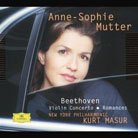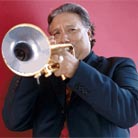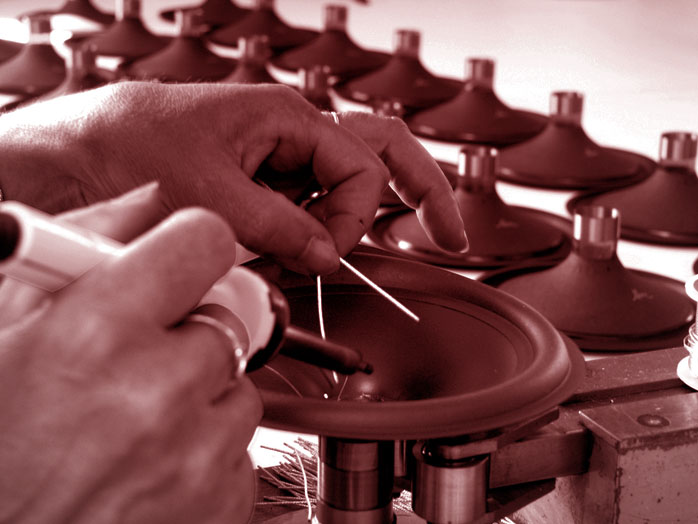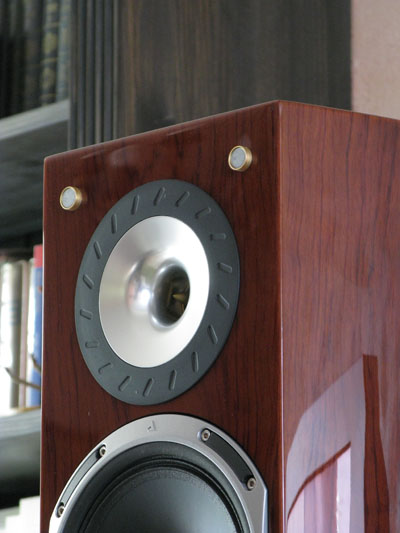This review page is supported in part by the sponsors whose ad banners are displayed below |
 |
 |
Sound: After these few technical considerations, how does the new SE perform? I had many past opportunities to listen to various Triangle speakers as the brand remains famous and widespread in our domestic French market. I nonetheless must confess to never having owned any of De Vergnette’s creations. Regardless, the Magellan series has won great acclaim in France and admiration even with myself especially for its Duetto monitors and entry-level Cello floorstander. These two speakers perfectly serve Triangle's voicing tradition with verve and integrity. The Grand Concert and Concerto always were been more turned for the exports markets and international exhibitions and perhaps the Quatuor was the most difficult of Magellan speakers to find and actually audition. So it really was an exciting proposition to have at home these beautiful speakers for a sufficiently long period to get a precise fix on the potential of Triangle’s latest high-end developments.
|
|
If each prior speaker released by the Villeneuve Saint Germain company always delivered great musicality, the new Quatuor SE enters a new dimension. This new pair of speakers is extremely musical. Of course it is difficult to define any precise criteria to measure musicality. But if you count the number of CDs you do not succeed to extract from your player before the last track has finished, perhaps this conveys the spirit. In spite of generally looking for a more neutral sound myself, I particularly enjoyed the Quatuor SE and it proved very difficult to press the stop button.
|
One of the most fundamental qualities that sprung to mind searching for descriptors was ease. The Quatuor SE impressed me favorably with its power to differentiate the various layers of sound in a three-dimensional stage even during the most complex orchestral recordings. Listening to the Berlin Philharmonic conducted by Karajan on Arthur Honegger’s Symphonies N°.2 and N°.3 [Deutsche Grammophon], the density of strings in the second movements is completely astonishing. “Liturgique” for full orchestra is delivered with firm authority but always remarkable delicacy and contrast. Polyphonic depth and beauty of instrumental colors are perfectly served by Triangle’s latest and when it becomes useful to take into consideration a kind of Debussian delicacy, the Quatuor SE simply delivers its best with total respect for the composer’s musical persona. |
|
|
 |
Granted, the Quatuor SE won’t give you the architectural deep soundstage of B&W’s biggest 800 Series models. But its resolving power, fluidity and spaciousness are truly exquisite and I fear that the 802D priced equivalently could easily lose the comparison. For their best, you should upgrade to the 801D model but in specific criteria, even that could remain far behind.
The Quatuor SE is a rather versatile loudspeaker. I took great pleasure listening to the Quatuor Debussy, especially their last outing of Mozart’s Requiem for Decca. I also particularly enjoyed the second and very controversial Mutter recording of Beethoven’s Concerto in D Major for violin with the NY Philharmonic conducted by Masur [Deutsche Grammophon]. This recording has always been quite difficult because of the disputed mannerisms of the German violinist. The Quatuor SE nevertheless succeeded to point out every subtle nuance in Anne-Sophie Mutter’s playing and the seemingly arbitrary phrasing changes and pitch and dynamic choices finally made much sense. The resolution of the Triangle Quatuor undoubtedly helped me to better appreciate Mutter’s boldness especially in the last movement.
Trying to escape from classical music and in particular the delightful enchantment of strings, I decided to assign a more difficult target to the Triangles with the unforgiving but electrifying Hiromi Uehara recording Beyond Standard [Telarc]. This means not that the previous recordings were easy fare but Triangle loudspeakers generally excel on strings and this one could be one of the best performers on the market right now.
I was sincerely surprised to observe the ease by which the French speakers delivered the recording’s live climate of Hiromi’s newest opus. The Quatuor SE had opportunity to demonstrate convincing bass extension whereas the upper frequencies were perfectly served with the improved seamless crossover transition. At realistic levels and high SPLs, the magnificent scale as well as the impressively clean and coherent sound image were always delivered in utter serenity. Compared to my previous auditions of Triangle speakers, the Quatuor SE seems to have drastically eradicated most of the brand’s weaknesses while conserving their identity and traditional strengths. The forward effect, the over-detailed focus, the rising treble response, the strong directivity and sometimes sharpness all seem to have been abolished.
|
|
|
|
 |
The music now is delivered in a more relaxed climate and for this significant evolution, I have to congratulate the technical staff of the French manufacturer. They really did a great job. This Special Edition model is a true achievement for the Magellan project! I am very curious now to listen to future SE iterations of other Magellan models. The tweeter band, although particularly detailed, is very smooth and sweet. It is truly one of the best tweeters I ever heard.
|
|
|
 |
I have at home a lot of unforgiving recordings for tweeters and at no moment did I sense any undue harshness. Even the great Arturo Sandoval failed to reveal any specific weaknesses. Need I say more? Another substantial improvement is the fact that the integration of tweeter and midrange seems more natural. This specific feature might be the effect of a better crossover or superior internal wiring and certainly lower phase distortion. The Quatuor SE gives the overall impression of greater transparency and fluidity than earlier models. But, more than that, the absence of any distinct directivity represents a great achievement for a Triangle loudspeaker and the Quatuor SE really shows it off.
|
 |
 |
This loudspeaker is very easy to set up. It needs just a minimum of space behind the enclosures to consent to a good result. Obviously the rear tweeter calls for a minimum and maximum distance and at 50cm between rear baffle and wall (I have no particular constraints with regard to side walls), it gave very satisfying results. Even though the tweeters are mounted well above ear height when seated, the remarkable dispersion of these units doesn't cause any noticeable problem. Moving to the sofa, then into the room, the musical scenery remained remarkably stable. It is of course not the best performer in this field but the improvements obtained by Triangle are absolutely remarkable.
I sincerely dislike loudspeakers which tend to simplify the musical message and my favored loudspeakers are generally very informative. In this regard, the Triangle is a top performer, one of the best I have ever experienced and with such a profusion of detail that many recordings were rediscovered as though for the very first time.
As nothing is perfect, the Magellan Quatuor SE also presents some limitations clearly linked to the brand’s sonic identity. The most conspicuous fact is the native coloration of the voicing. It can be perceived as a pleasant or annoying feature depending on what you are looking for: accurate and vivid sound or tonal veracity? Finding an absolutely neutral speaker might be difficult but several other products in this price range offer better timbre contrasts from one recording to another. Obviously I had also the opportunity to listen to speakers more colored than this Triangle and I must admit that the Triangle voicing remains particularly seductive.
|
|
|
|
The bass register is not the best attribute of the Triangle and my McIntosh LS360 with its larger drivers offers better articulation in the low frequencies. Triangle’s bass extension is nevertheless improved compared to previous models and maybe the most critical point should be that the astonishing level of sound produced by the treble and midrange units could have led to a more ambitious bass section with larger drivers but this would clearly be another story.
Though this SE version is more versatile than the previous versions, Triangle remains to my mind very focused on classical music and Jazz for which it is an excellent protagonist. But if you are looking to more subsonic fare, you will find better performers outside Triangle’s sphere though I had personally no problems with the Triangle matching my favorite musical styles to perfection.
Conclusion: The Magellan Quatuor SE is an expensive loudspeaker which still represents value for money given its sonic performance and build quality. Globally, the Quatuor SE is highly competitive and clearly above other products I had opportunity to audition recently in the same price range. With this revised model, Triangle is definitely proposing an unfussier speaker that is more neutral than previous models but recognizably retains the same sound philosophy (and keep in mind that these improvements register atop a very high pre-existing base line). The expansive soundstage and resolving power of the Quatuor SE are among the best available on the market at their price.
|
 |
|
 |
With the arrival of the Quatuor SE, I can honestly declare that sweetness is henceforth a part of Triangle’s sonic universe, undoubtedly a great achievement. More than this, I never had the feeling during my time with the French speakers that their high resolution played against the core virtues of any recording. The Quatuor SE also demonstrated to be a very friendly product and this specific feature has to be highlighted as it is not so frequent in the upper-end sector. In fact, the new Triangle is very easy to set up in the listening room and presents no particular directivity problems. It also has a strong chance to be venerated by your wife thanks to its reasonable dimensions and luxury appearance. This new Triangle is a product I should recommend to music lovers looking for a very musical pair of speakers that will remain in their living room for a very long time.
The tonal tendency of the Quatuor SE nevertheless remains on track and the continuity with Triangle’s house sound is certain, albeit more accomplished and delivered in a more relaxed mood. Despite being generally less compelling on rock and pop than classical and Jazz, the Quatuor SE gave me the impression of being more versatile than its predecessors. Thus, I have no hesitation to call the Quatuor SE among the best of class. If you desire more than anything else to listen to big orchestral works with a wide soundstage and a high level of detail but without entertaining a monkey coffin in your living room, you should seriously consider the new Triangle Electroacoustique Magellan Quatuor SE! |
|
|
|
Quality of packing: Very good.
Reusability of packing: A few times.
Ease of unpacking/repacking: Reasonably easy with a dolly. Leave the slip covers in place until final touch-down in the chosen location to protect the flawless finish.
Condition of component received: Flawless.
Completeness of delivery: Perfect and remarkable for the quality of ancillaries.
Human interactions: International sales manager very responsive and helpful.
Pricing: Excellent value for money.
Final comments & suggestions: Spiking and correct adjustment of SPEC system are mandatory for good and precise bass extension. The Quatuor SE like other Triangle products needs power. Big solid-state amps or bulky tube amps are highly recommended to get the best performances. Bi-wiring is also convenient to improve the mid-bass register. |
|
|
|
|
 |